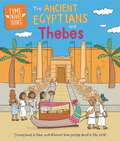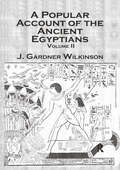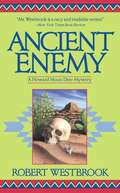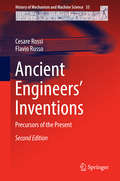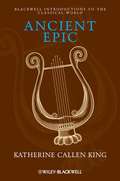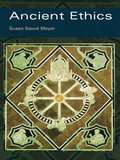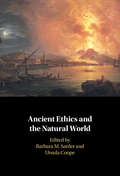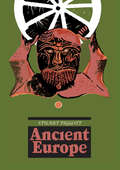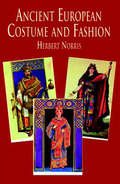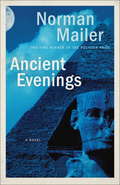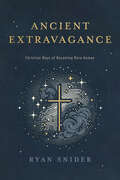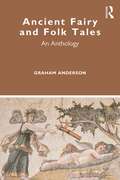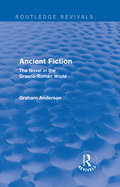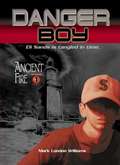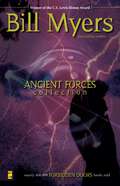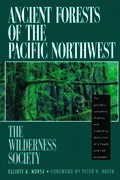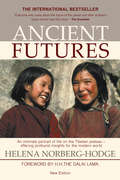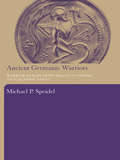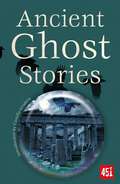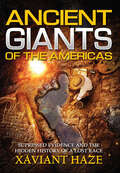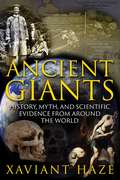- Table View
- List View
Ancient Egyptians and Thebes: Travel Back In Time And Discover How People Lived In The Past (Time Travel Guides #8)
by Sarah RidleyTravel back in time to the ancient Egyptian city of Thebes and find out all about ancient Egyptian life and culture.Travel back in time to Thebes and find out all about life and culture there. Sail down the River Nile, visit the awe-inspiring pyramids and temple complex at Karnak and Luxor and join in the fun at a festival! Like modern travel guides, the books in this series highlight must-see features and explain local culture. Each highlighted destination contains an explanation of what took part in these areas, as well as a look at important artefacts found there providing a bigger picture of life in the past. Typical travel guide notes include, 'best time to visit', 'what to eat' and 'where to stay'. Perfect for the KS2 history curriculum, and for readers aged 7 and up.Contents:Thebes Putting Thebes on the Map Sail Down the Nile Stop Off at the Pyramids Where To Stay Dress Like An Ancient Egyptian A Quick Guide To Gods and Goddesses Visit Some Temples Go To a Festival Death and Mummies Watch a Funeral Procession Tutankhamun Visit Quick! Glossary Further Information Index Books in this series:The Maya and Chichén ItzáRoman Britain and LondiniumThe Stone Age and Skara BraeViking Britain and JorvikAncient Greece and AthensThe Shang Dynasty and YinLondon and the VictoriansAncient Egypt and Thebes
Ancient Egyptians and Their Neighbors: An Activity Guide
by Marian BroidaWant to speak Hittite? Hold out a glass and ask for "wa-tar." This unique activity book for children ages nine and up shows what life was like among the Nubians, Mesopotamians, Hittites, and their neighbors the Egyptians from around 3100 B.C., when Upper and Lower Egypt became one kingdom, to the death of Queen Cleopatra under the Romans, in 30 B.C. Projects such as building a Nubian irrigation machine, creating a Mesopotamian cylinder seal out of clay, making kilts like those worn by Egyptian boys and men, and writing in Hittite cuneiform help young readers to connect with these ancient cultures and see how profoundly they have influenced our own.
Ancient Egyptians: Revised And Abridged From His Larger Work (classic Reprint) (African Heritage Classical Research Studies)
by J. Gardner WilkinsonWritten in 1836, this two-volume study has enduring importance in the field of Egyptology. Covering topics including Egyptian homes, ceremonies, hunting, religious rites, and castes, it provides a comprehensive account of ancient Egyptian life and practices. The work is illustrated with numerous anecdotes and hundreds of beautiful woodcuts.
Ancient Enemy
by Robert WestbrookThe murder of an archaeologist fuels an heated war between natives and those excavating their land. When the coroner confirms that the victim was cannibalized, the story takes a twisted turn.
Ancient Engineers' Inventions: Precursors of the Present (History of Mechanism and Machine Science #33)
by Cesare Rossi Flavio RussoThis book describes the inventions and designs of ancient engineers who are the precursors of the present. The period ranges mainly from 300 B. C. to 1600 A. D. with several exceptions. Many of the oldest inventions are documented by archaeological finds, often very little known, mainly from Pompeii, Herculaneum and Stabiae and reveal a surprising modernity in their conception. Most of the inventions presented in the first four parts of this book were conceived up to the late Roman Empire and may be considered as milestones, each in their respective field. The fifth part concentrates on more recent centuries. The sixth part deals with some building construction techniques. Generally, for each of the presented inventions, three elements of research and reference are provided: written documents (the classics), iconic references (coins, bas-reliefs, etc. ) and archaeological findings. The authors did not write this book for engineers only; hence they describe all the devices without assuming wide technical knowledge. The authors' main aim is to try to communicate their enthusiasm for the inventions and the inventors of the past and to contribute to the fascinating study of the History of Engineering. This second edition includes new topics and chapters that are of special interest to engineers.
Ancient Epic (Blackwell Introductions to the Classical World #35)
by Katherine Callen KingAncient Epic offers a comprehensive and accessible introduction to six of the greatest ancient epics – Homer's Iliad and Odyssey, Vergil's Aeneid, Ovid's Metamorphoses, and Apollonius of Rhodes' Agonautica. Provides an accessible introduction to the ancient epic Offers interpretive analyses of poems within a comprehensive historical context Includes a detailed timeline, suggestions for further readings, and an appendix of the Olympian gods and their Akkadian counterparts
Ancient Ethics
by Susan Sauvé MeyerThis is the first comprehensive guide and only substantial undergraduate level introduction to ancient Greek and Roman ethics.It covers the ethical theories and positions of all the major philosophers (including Socrates, Plato and Aristotle) and schools (Stoics and Epicureans) from the earliest times to the Hellenistic philosophers, analyzing their main arguments and assessing their legacy. This book maps the foundations of this key area, which is crucial knowledge across the disciplines and essential for a wide range of readers.
Ancient Ethics and the Natural World
by Barbara M. Sattler Ursula CoopeThis book explores a distinctive feature of ancient philosophy: the close relation between ancient ethics and the study of the natural world. Human beings are in some sense part of the natural world, and they live their lives within a larger cosmos, but their actions are governed by norms whose relation to the natural world is up for debate. The essays in this volume, written by leading specialists in ancient philosophy, discuss how these facts about our relation to the world bear both upon ancient accounts of human goodness and also upon ancient accounts of the natural world itself. The volume includes discussion not only of Plato and Aristotle, but also of earlier and later thinkers, with an essay on the Presocratics and two essays that discuss later Epicurean, Stoic, and Neoplatonist philosophers.
Ancient Europe
by Stuart PiggottThis book interprets the main lines of European prehistory from the first agricultural communities in the sixth or even seventh millennium B.C. until the incorporation of much of barbarian Europe within the Roman Empire. It traces the beginnings of animal domestication and plant cultivation in ancient Western Asia, and the transmission of these skills by movements of peoples or by assimilation, in the European continent. The early technology of working in copper, and later in bronze, is discussed. Metal winning and working, and trade in raw materials and finished products, brought social and political repercussions to barbarian and civilised peoples alike.The spread of the Indo-European languages is considered in its archaeological context, as is the formation of the Celtic peoples, soon to acquire iron technology and to become the main barbarian component in Europe, side-by-side with the civilised Mediterranean societies, Greek, Etruscan or Roman. The later Celtic world of Europe and the British Isles is examined, and an attempt made to estimate the contribution of the older barbarian world to the Europe, which emerged from the ruins of the Roman Empire, geographically, the book ranges over the whole European field, from the Atlantic shores to the Urals and the Caucasus. While it does not pretend to be a prehistory of Europe within the period chosen, the book does bring together and discuss for the first time much scattered and often little-known archaeological evidence.This book is organized in a manner that will permit it being read on two levels. For the general non-specialist reader, the text and illustrations should give a sufficient idea of the nature of the theme and of the evidence, and of the development of the barbarian cultures side-by-side with the civilizations of antiquity, as their precursors and their subsequent counterparts. For the archaeological student however the text is documented with rather full references and notes at the end of each chapte
Ancient European Costume and Fashion
by Herbert NorrisScrupulously researched book by noted authority traces the development of European clothing styles from prehistory to the Norman Conquest in A.D. 1066. Over 160 illustrations, including 17 full-color plates, display draped robes of classical Greece, the jewel-encrusted apparel of a 10th-century Byzantine emperor, garments of peasants, as well as footwear, hairstyles, headdresses, and jewelry.
Ancient Evenings
by Norman MailerNorman Mailer's dazzlingly rich, deeply evocative novel of ancient Egypt breathes life into the figures of a lost era: the eighteenth-dynasty Pharaoh Rameses and his wife, Queen Nefertiti; Menenhetet, their creature, lover, and victim; and the gods and mortals that surround them in intimate and telepathic communion. Mailer's reincarnated protagonist is carried through the exquisite gardens of the royal harem, along the majestic flow of the Nile, and into the terrifying clash of battle. An extraordinary work of inventiveness, Ancient Evenings lives on in the mind long after the last page has been turned.
Ancient Extravagance: Christian Ways of Becoming More Human
by Ryan SniderFind the beautiful and come alive. We are all frittering away our lives—at least according to someone. They tell us to be productive and not waste our opportunities. In Ancient Extravagance, Ryan Snider shows us that life is more than our accomplishments and what we do. The key to a life of meaning is developing our spiritual senses, which only come awake when we worship with others. That might seem like a waste of time, but in fact, these ancient practices have the power to wake up all parts of our lives—not just Sunday morning. Snider begins with a recovery of childlike wonder and story, reclaiming how prose, poetry, memory, and reflection heal and strengthen the soul. Next, he turns to melodies our grandmothers taught us, examining how they reach into our bones. He then reflects on what it means to eat meals with strangers and how a simple act of hospitality can gently inscribe love, generosity, gratitude, and hospitality in our hearts. These seemingly insignificant practices are mustard seeds that grow into trees to create shade for the world. When we cease simply going to worship and start becoming the worship, we will discover the friendships, beauty, purpose, stories, and sacred moments that will save us and make us more human. Deeply meaningful and delightfully humorous, candid yet surprising, Ancient Extravagance will connect you with a more beautiful and meaningful life.
Ancient Faces: Mummy Portraits in Roman Egypt (A\catalogue Of Roman Portraits In The British Museum Ser. #Pt. 4)
by Susan WalkerFrom the first major discoveries a century ago, the painted portraits of Roman Egypt were a revelation to scholars and the public alike, and the recent finding of a new cache of these gilded images, which made national headlines, have only heightened their mystery and appeal. Published to coincide with a new major exhibition of these portraits, Ancient Faces is the most comprehensive, up-to-date survey of these astonishing works of art.Dating from the later period of Roman rule in Egypt, shortly before the birth of Christ, the painted mummy portraits are among the most remarkable products of the ancient world, a fusion of the traditions of pharonic Egypt and the Classical world. They are historical and cultural objects of outstanding importance and beauty, superb works of art that represent some of the earliest known examples of life-like portraiture. Though the subjects of the portraits believed in the traditional Egyptian cults, which offered them a firm prospect of life after death, they also wished to be commemorated in the Roman manner, with their fashion of dress and adornment signaling their status in life. Despite their ancient history, these portraits speak to the modern eye with a beauty and intensity that would be lost to portraiture until the Renaissance.
Ancient Fairy and Folk Tales: An Anthology
by Graham AndersonThis anthology explores the multitude of evidence for recognisable fairy tales drawn from sources in the much older cultures of the ancient world, appearing much earlier than the 17th century where awareness of most fairy tales tends to begin. It presents versions of Cinderella, The Emperor’s New Clothes, Snow White, The Frog Prince and a host of others where the similarities to familiar ‘modern’ versions far outweigh the differences. Here we find Cinderella as a courtesan, Snow White coming to a tragic end or an innocent heroine murdering her sisters. We find an emperor’s new clothes where the flatterers compare him to Alexander the Great, or a pair of adulterers caught in a magic trap. Tantalising fragments suggest that there is more to be discovered: we can point to a Sleeping Beauty where the girl takes on the green colouring of the surrounding wood, or we encounter a Rumpelstiltskin connected to a mystery cult. The overall picture suggests a much richer texture of popular tale as a fascinating new legacy of antiquity. This volume breaks down the traditional barriers between Classical Mythology and the fairy tale, and will be an invaluable resource for anyone working on the history of fairy tales and folklore.
Ancient Fiction: The Novel in the Graeco-Roman World (Routledge Revivals)
by Graham AndersonA number of ancient novelists were skilful storytellers and resourceful literary artists, and their works are often carefully individualised presentations of an ancient and distinguished heritage. Ancient Fiction, first published in 1984, examines the tales retold by these novelists in light of more recently discovered Near Eastern texts, and in this way offers a tentative solution to Rohde’s celebrated problem about the origins of the Greek novel. Among the surprises that emerge are an ancient stratum of the Arabian Nights and a possible Tristan-Romance, as well as an animal Satyricon and a human Golden Ass. This new framework is, however, incidental to an examination of the achievements of ancient novelists in their own right. In presenting character, structuring narrative, imposing a veneer of sophistication or contriving a religious ethos, these writers demonstrate that their work is worthy of sympathetic study, rather dismissal as the pulp fiction of the ancient world.
Ancient Fire (Danger Boy #1)
by Mark London WilliamsHitch a ride through time on the Danger Boy adventures! These rich, action-filled fantasies about a reluctant time-traveler and his unusual sidekicks will keep readers on the edge of their seats. The year is 2019, and a secret government agency is forcing Eli's dad to continue with his time-travel experiments, even though Eli's mom has just disappeared in one. Now Eli has a ridiculous new code name -- and a gravely important mission. In DANGER BOY: ANCIENT FIRE, a lab accident sends Eli sprawling through the Fifth Dimension, where he hooks up with the amiable Clyne, an evolved dinosaur from an alternate Earth who just wants to finish his homework. Clyne's timeship lands them in ancient Alexandria, Egypt, just as a great fire rages through the city and the girl scientist Thea is fleeing an angry mob who thinks she's a witch. As if that's not enough, in the present-day world, a deadly pox is on the loose, and bizarre things are starting to happen to the fabric of time itself.
Ancient Forces Collection (Forbidden Doors)
by Bill MyersIn Volume 4 of the bestselling Forbidden Doors supernatural fiction series, author Bill Myers presents books 10-12-The Ancients, The Wiccan, and The Cards-stories to unmask dangerous occultic influences in young adult lives. With insight and his unsurpassed ability to weave a suspensful story, each volume explores spiritual warfare by presenting biblical truths through realistic situations.
Ancient Forests of the Pacific Northwest
by Peter H. Raven The Wilderness Society Elliott A. NorseAncient Forests of the Pacific Northwest provides a global context for what is happening in the Pacific Northwest, analyzing the remaining ancient forest and the threats to it from atmospheric changes and logging. It shows how human tampering affects an ecosystem, and how the Pacific Northwest could become a model for sustainable forestry worldwide.
Ancient Forgiveness
by Charles L. Griswold David KonstanIn this book, eminent scholars of classical antiquity and ancient and medieval Judaism and Christianity explore the nature and place of forgiveness in the pre-modern Western world. They discuss whether the concept of forgiveness, as it is often understood today, was absent, or at all events more restricted in scope than has been commonly supposed, and what related ideas (such as clemency or reconciliation) may have taken the place of forgiveness. An introductory chapter reviews the conceptual territory of forgiveness and illuminates the potential breadth of the idea, enumerating the important questions a theory of the subject should explore. The following chapters examine forgiveness in the contexts of classical Greece and Rome; the Hebrew Bible, the Talmud, and Moses Maimonides; and the New Testament, the Church Fathers, and Thomas Aquinas.
Ancient Futures, 3rd Edition
by Helena Norberg-Hodge H.H. the Dalai LamaA moving portrait of tradition and change in Ladakh, or “Little Tibet,” Ancient Futures is also a scathing critique of the global economy and a rallying call for economic localization. When Helena Norberg-Hodge first visited Ladakh in 1975, she found a pristine environment, a self-reliant economy and a people who exhibited a remarkable joie de vivre. But then came a tidal wave of economic growth and development. Over the last four decades, this remote Himalayan land has been transformed by outside markets and Western notions of “progress.” As a direct result, a whole range of problems—from polluted air and water to unemployment, religious conflict, eating disorders and youth suicide—have appeared for the first time. Yet this is far from a story of despair. Social and environmental breakdown, Norberg-Hodge argues, are neither inevitable nor evolutionary, but the products of political and economic decisions—and those decisions can be changed. In a new Preface, she presents a kaleidoscope of projects around the world that are pointing the way for both human and ecological well-being. These initiatives are the manifestation of a rapidly growing localization movement, which works to rebuild place-based cultures—strengthening community and our connection with nature. Ancient Futures challenges us to redefine what a healthy economy means, and to find ways to carry centuries-old wisdom into our future. The book and a related film by the same title have, between them, been translated into more than 40 languages.
Ancient Geopolymers in South America and Easter Island (SpringerBriefs in Earth Sciences)
by Joseph DavidovitsThis book presents the study on Ancient Geopolymers in South America and Easter Island regions, exploring the artificial nature of the volcanic rocks used in the construction of Easter Island's statues. Contrary to the belief that the statues were carved and transported, Davidovits suggests they were made on-site using geopolymer technology. He proposes that this knowledge came from Amerindians from the Andes, specifically the Tiahuanaco region near Lake Titicaca. The book is divided into two parts: the first examines geopolymeric artificial stone technologies in the Andes, and the second establishes a connection between these technologies and Easter Island, 3,700 km away. Davidovits' research includes geological expeditions, SEM analysis, petrography, and a comprehensive review of international literature. It is intriguing to observe that in both cases, Pumapunku /Tiwanaku in the Andes and Easter Island, volcanic rocks are involved which contain biological carbon. These discoveries undeniably support the theory of geopolymeric artificial manufacturing, challenging traditional archaeological views.
Ancient Germanic Warriors: Warrior Styles from Trajan's Column to Icelandic Sagas
by Michael P. SpeidelPresenting a range of evidence for these diverse styles, from Roman art to early medieval bracteate amulets, and from classical texts to Beowulf, the Edda and Icelandic sagas, Professor Speidel here details seventeen different Germanic warriors styles, including berserks, wolf-warriors, club-wielders, long-hairs, ghost warriors and horse-stabbers, and how they indicate an unbroken continuity of customs, beliefs and battle-field tactics. Ancient Germanic warriors played a decisive role in historical events from 200 BC, when Germanic culture first became identifiable, to AD 1000 when Christianity swept through the Nordic countries. Arising from beliefs and states of mind, a variety of warrior styles manifested themselves in differences of dress, weaponry and fighting technique. Fully illustrated with over fifty photographs, this vivid and fascinating survey adds a colourful new dimension to our understanding of the history of Europe.
Ancient Ghost Stories (Ghost Stories)
by Flame TreeGhosts and apparitions abound across the peoples of the early civilisations, from the Ancient Egyptians, the Babylonians, Greeks, Romans and the Vikings too.Phantoms of the dead, warning apparitions and necromancy – there are many stories of ghosts to be found in the retold literature of ancient peoples: &‘Khonsemhab and the Ghost&’ and &‘The Adventure of Setne Khamwas with the Mummies&’, both from Ancient Egypt; &‘Philinnion and Machates&’ from Ancient Rome; spirits featured in Homer&’s Odyssey, from Ancient Greece; tales of Babylonian demons and the netherworld; and stories of fire apparitions from Japan. The Vikings too had their fair share of ghosts, such as crop up in the 13th-century Icelandic Laxdaela Saga. These stories are all brought together in this new collection for an intriguing insight into the spirit world of early cultures.FLAME TREE 451: From myth to mystery, the supernatural to horror, fantasy and science fiction, Flame Tree 451 offers a healthy diet of werewolves and mechanical men, blood-lusty vampires, dastardly villains, mad scientists, secret worlds, lost civilizations and escapist fantasies. Discover a storehouse of tales gathered specifically for the reader of the fantastic.
Ancient Giants of the Americas: Suppressed Evidence and the Hidden History of a Lost Race
by Xaviant HazeDid a race of ancient giants once inhabit the Americas?Do ancient megalithic stoneworks, out-of-place artifacts, DNA mysteries, and strange bones provide proof of their existence?Ancient Giants of the Americas reveals an array of astounding truths, including:How giants were a dominant feature of Native American origin myths.Extraordinary first-person tales about meetings with giant Native Americans.How early pioneers discovered the remains of ancient giants and a previously unknown civilization—and how the Smithsonian successfully covered them up.Analyzing the historical and archaeological evidence, Xaviant Haze provides ample proof that our ancestors in the ancient Americas were much taller and a lot more mysterious than we imagine. Their exploits inspired the Native Americans to keep oral accounts of these mysterious giants, who left behind strange artifacts, massive cities of burial mounds, and the remains of a vast copper-mining network.Who were these ancient giants? Did some really have six toes? Were some related to the elongated-skull peoples of Peru? Your view of American history will never be the same after going down the giant rabbit hole that is Ancient Giants of the Americas.
Ancient Giants: History, Myth, and Scientific Evidence from around the World (Discovering Ancient America Ser.)
by Xaviant HazeInvestigates physical evidence, history, and myths to reveal the lost race of giants that once dominated the world • Reveals suppressed archaeological and scientific discoveries supporting the existence of a worldwide race of giants • Examines giant myths and legends from ancient religious texts and literature from around the world • Includes findings from throughout Europe (Britain, France, Spain, Italy, Germany, and Russia), the Middle East (Israel, Egypt, Syria, Iraq, and Iran), Africa, Australia, New Zealand, and the Far East (China, Japan, Malaysia, and the Philippines) From the Nephilim and Goliath in the Bible to the Titans in Greek mythology and the Fomorians and Frost Giants in Celtic and Nordic lore, almost every culture around the world has spoken of an ancient race of giants. Giant footprints left in the geological bedrock, tens of thousands of years old, have been discovered in India, China, and the war-torn lands of Syria. Giant bones and full skeletons have been found in Europe, the Middle East, Africa, Australia, and Asia. Yet despite mounting evidence, mainstream science continues to consign these findings to the fringe. Examining global myths, historical records, megalithic ruins, and archaeological findings, Xaviant Haze provides compelling evidence for a lost race of giants in Earth’s prehistory. He explores myths that go back thousands of years, including those found in the world’s holiest scriptures, as well as medieval and modern myths, such as Geoffrey of Monmouth’s account of the first kings of Britain and the stories of giant bones unearthed by Allied soldiers during World War II. He investigates historical reports of ancient giants found in Ireland and the British Isles—the remains of which mysteriously disappeared shortly after their discovery. He explores the legends of giants in Russia and goes deep into the Far East, revealing the multitude of fascinating giant legends in China. Haze explains how giants were responsible for the megalithic wonders of Malta and how the early settlers of Australia discovered the remains of giants but these findings were suppressed by the Royal Academies. He also explores the mythic origins of the giants: Were they the hybrid results from genetic experiments of ancient aliens or from the interbreeding of the fallen angels with the daughters of man? Covering legends and finds from throughout Europe, the Middle East, Africa, Australia, New Zealand, and the Far East, Haze also presents--in its entirety--The Book of Giants, a portion of the Dead Sea Scrolls suppressed due to its overwhelming support for the existence of giants in antiquity.
